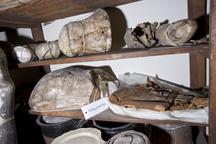

A circular dividing plate, for laying out angular graduations on small instruments, showing signs of having been made by a workman (perhaps Watt himself) for his own use, and of some, but not much, subsequent use, unsigned.
This item is part of the contents of the workshop that Scottish engineer James Watt developed at his home, Heathfield, at Handsworth, Birmingham, from c.1795 through to his death in 1819. Although Watt is best known for his work on the steam engine, his workshop contains a wide variety of objects from many different projects, from chemistry to sculpture-copying.
The description of the item was written by Edward Collins, the land agent responsible for Heathfield when the workshop was given to the Science Museum in 1924. Collins could not always identify what he was looking at, but always described what he saw clearly. This has allowed his descriptions to form the basis of subsequent research.
This item may have been constructed for use by Watt in the early part of his career, when he was working as a scientific instrument maker in Glasgow. He took a professional interest in dividing both angular and linear scales, the former for instruments like sextants, and the latter for theromometers and barometers, and items related to their manufacture remain in the workshop.
Details
- Category:
- James Watt's Garret Workshop
- Object Number:
- 1924-792/1309/11
- Materials:
- brass (copper, zinc alloy)
- Measurements:
-
overall: 2 mm 212 mm, .98kg
- type:
- dividing plate
- credit:
- Major J.M. Gibson-Watt




